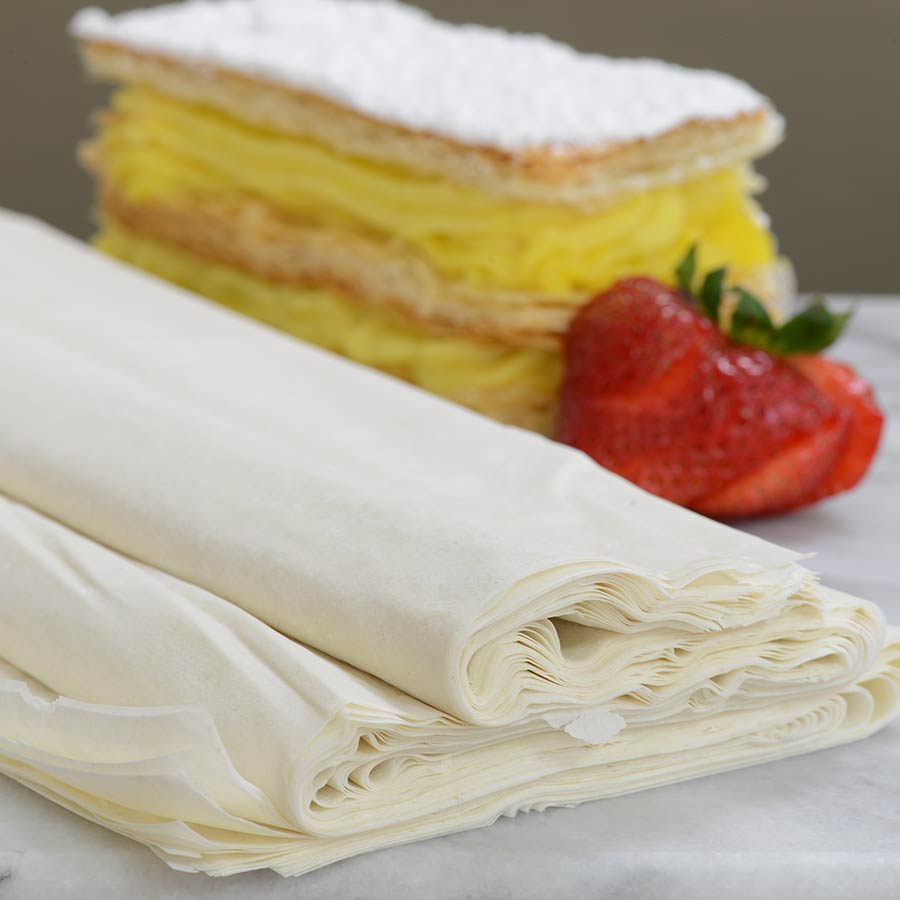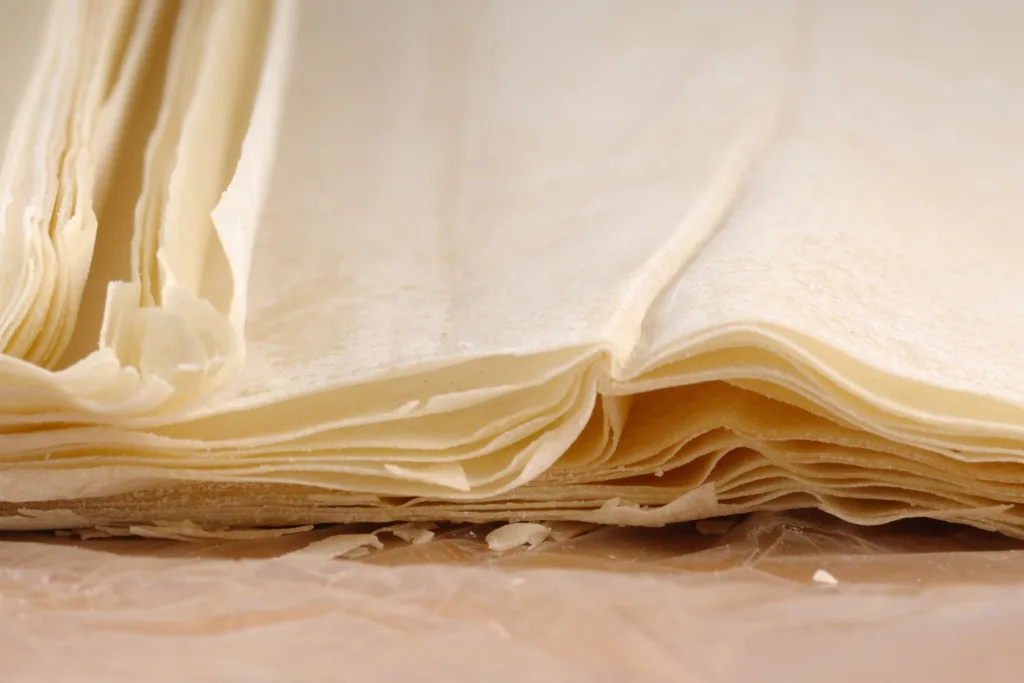Phyllo dough is a versatile ingredient that is used in many different types of dishes, from sweet desserts to savory appetizers. This thin, flaky pastry is made from multiple layers of paper-thin dough that is brushed with butter or oil and then baked to a crisp, golden brown. Many people wonder how long phyllo dough can be stored in the fridge, and the answer is that it depends on whether the dough is fresh or frozen.
Fresh phyllo dough can be kept in the refrigerator for up to two weeks if it is kept tightly wrapped or in its original packaging. It is important to keep the dough sealed and protected from air and moisture in order to prevent it from drying out and becoming brittle. If the dough becoms too dry, it will be difficult to work with and may crack or tear when you try to handle it.
If you have leftover phyllo dough that you want to store in the fridge, it should be wrapped tightly in plastic wrap or aluminum foil and placed in an airtight container. This will help to keep it fresh and prevent it from drying out. You can also use a zip-top plastic bag to store the dough, but be sure to remove as much air as possible before sealing the bag.
Frozen phyllo dough can be stored in the freezer for up to four months. It is important to make sure that the dough is tightly wrapped and protected from air and moisture in order to prevent freezer burn. If the dough is not properly stored, it may become dry and brittle, which will make it difficult to work with.
When you are ready to use phyllo dough that has been stored in the fridge or freezer, it is important to let it come to room temperature before working with it. This will help to prevent the dough from cracking or tearing when you try to handle it. Once the dough has reached room temperature, you can use it to make a variety of different dishes, such as baklava, spanakopita, or other savory or sweet pastries.
Phyllo dough can be stored in the fridge for up to two weeks if it is kept tightly wrapped or in its original packaging. Frozen phyllo dough can be stored in the freezer for up to four months. It is important to keep the dough sealed and protected from air and moisture in order to prevent it from drying out and becoming brittle. When you are ready to use the dough, be sure to let it come to room temperature before working with it. With proper storage and handling, phyllo dough can be a versatile and delicious addition to your culinary repertoire.
How Long Does Thawed Filo Last in the Refrigerator?
Thawed filo, also known as phyllo dough, should be stored in the refrigerator and consumed within three days. It is important to keep the filo dough covered with plastic wrap or a damp towel to prevent it from drying out. If the filo dough has been thawed and remains unused after three days, it should be discarded.
To extend the shelf life of filo dough, it can be frozen for up to three months. When freezing filo dough, it is recommended to wrap it tightly in plastic wrap or aluminum foil, and then place it in an airtight container or freezer bag.
It is important to note that once filo dough has been thawed and refrozen, its quality may be compromised. It is best to use filo dough immediately after thawing or to only thaw the amount needed for a partcular recipe.
It is important to properly store and handle filo dough to ensure its freshness and quality. By following the recommended storage guidelines, filo dough can be enjoyed in a variety of delicious recipes.

Storing Filo Pastry in the Refrigerator
Filo pastry is a delicate pastry that is commonly used in various dishes, including Greek and Middle Eastern cuisines. If you have leftover filo pastry or have purchased it in advance, you may be wondering how long it will keep in the fridge.
Unopened fresh filo pastry typically has a shelf life of about two to thee weeks in the fridge. It is important to check the best before date on the packaging before using it, as the shelf life may vary depending on the manufacturer.
Once you have opened the filo pastry, it is best to use it as soon as possible to avoid it drying out or becoming brittle. If you need to store it for a short period, you can wrap it tightly in plastic wrap or airtight container and store it in the fridge for up to a week.
If you have leftover filo pastry that you cannot use within a week, you can freeze it to extend its shelf life. Frozen filo pastry can last for up to three months in the freezer. It is recommended to wrap the filo pastry tightly in plastic wrap or foil to prevent freezer burn and maintain its freshness.
To summarize, unopened fresh filo pastry can last for about two to three weeks in the fridge, while opened filo pastry should be used as soon as possible or stored in the fridge for up to a week. Frozen filo pastry can last up to three months in the freezer if wrapped tightly to prevent freezer burn.
Storing Filo Pastry in the Fridge
You can store filo pastry in the fridge. Filo pastry is a delicate and thin pastry that is commonly used in Mediterranean and Middle Eastern cuisine. It is made of several thin layers of dough that are separated by a layer of oil or butter.
To store filo pastry, it is important to keep it in its original packaging and seal it tightly. The packaging will help to prevent the pastry from drying out or becoming stale. If the pastry has been opened, it can be placed in a resealable plastic bag or wrapped tightly in plastic wrap before being stored in the fridge.
Make sure to place the filo pastry in the coldest part of the fridge, which is usually the back of the bottom shelf. This will help to ensure that the pastry stays fresh and does not spoil. Filo pastry can be stored in the fridge for up to a week, but it is best to use it as soon as possible for the best results.
When you are ready to use the filo pastry, make sure to handle it gently as it can tear easily. Allow the pastry to come to room temperature before using it, which will help to make it more pliable and easier to work with. If the pastry becoms too dry or brittle, it can be brushed with a bit of melted butter or oil to help soften it.
Filo pastry can be stored in the fridge for up to a week as long as it is kept in its original packaging or wrapped tightly to prevent drying out. When ready to use, handle the pastry gently and allow it to come to room temperature before using it.
Storing Defrosted Filo Pastry
Filo pastry, also known as phyllo dough, is a popular ingredient used in various sweet and savory dishes. If you have some defrosted filo pastry left over from a previous recipe, you may be wondering how long you can keep it and still use it safely.
It is generally recommended that defrosted filo pastry should be used within 2 to 3 days afer thawing. This is because the pastry is more susceptible to spoilage and bacterial growth once it has been thawed.
If you are not planning to use the defrosted filo pastry within the recommended time frame, it is best to freeze it again to prevent spoilage. Keep in mind that re-freezing filo pastry may affect its quality and texture, so it is important to use it as soon as possible after thawing.
To ensure the freshness and quality of defrosted filo pastry, it is important to store it properly. Keep the pastry in an airtight container or wrap it tightly in plastic wrap to prevent moisture and air from getting in. This will help to maintain the crispness and texture of the pastry.
Defrosted filo pastry should be used within 2 to 3 days after thawing and can be frozen again to extend its shelf life. Proper storage is key to maintaining the freshness and quality of the pastry.

Conclusion
Phyllo dough is a versatile pastry that can be used in a variety of sweet and savory dishes. It is important to store the dough properly, wether it is fresh or frozen, to ensure its quality and freshness. Leftover pastry can also be stored for later use. With its delicate and flaky texture, Phyllo dough adds a unique and delicious element to any dish. Whether you are making baklava, spanakopita, or any other Phyllo-based dish, it is sure to be a crowd-pleaser. So, don’t be afraid to experiment with this delicious pastry and add your own twist to traditional recipes!
